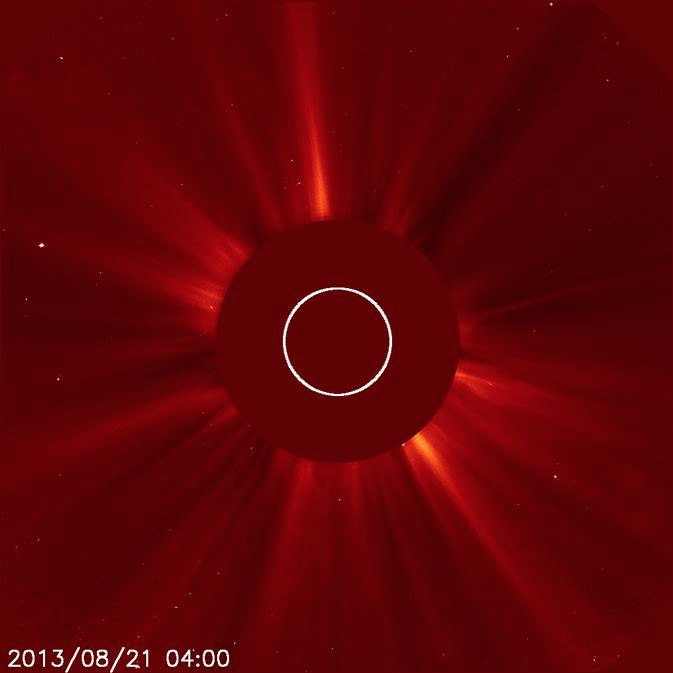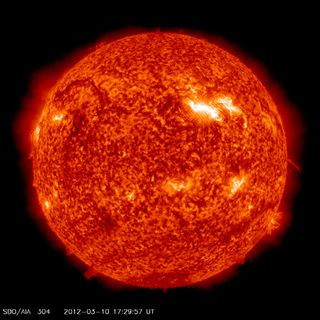Sun Unleashes Another Solar Storm Aimed at Earth

The sun fired off an intense solar storm at Earth Wednesday (Aug. 21) — the second in two days — hurtling billions of tons of charged particles at our planet, but should not pose a threat to people on the ground, NASA says.
The solar eruption, called a coronal mass ejection, occurred yesterday at 1:24 a.m. EDT (0524 GMT) and sent charged particles streaking outward at 380 miles per second. That's just over 1.3 million mph (2.2 million km/h). The solar fallout from the sun storm is expected to reach Earth within the next three days.
"These particles cannot travel through the atmosphere to harm humans on Earth, but they can affect electronic systems in satellites and on the ground," NASA officials explained in a statement. [Solar Max Photos: Sun Storms of 2013]
Wednesday's solar storm erupted just 21 hours after another powerful coronal mass ejection (NASA calls them CMEs) on Tuesday (Aug. 20). That solar tempest also sent billions of tons of solar particles on their way to Earth.
"Earth-directed CMEs can cause a space weather phenomenon called a geomagnetic storm, which occurs when they funnel energy into Earth's magnetic envelope, the magnetosphere, for an extended period of time," NASA officials said in a description of Wednesday's solar eruption. "The CME’s magnetic fields peel back the outermost layers of Earth's fields changing their very shape. In the past, geomagnetic storms caused by CMEs of this strength have usually been mild."

Powerful geomagnetic storms can affect communications signals and spark electrical surges in power grids, NASA officials said. They can also supercharge northern lights displays or aurora observers at high latitudes.
According to Spaceweather.com, a website that tracks space weather and skywatching events, the two solar eruptions this week were triggered when vast rope-like filaments of magnetic solar plasma erupted. The CMEs should arrive at Earth in time for weekend aurora watching for stargazers at high latitudes.
Get the Space.com Newsletter
Breaking space news, the latest updates on rocket launches, skywatching events and more!
"NOAA forecasters expect the CMEs to arrive on August 23-24, possibly sparking geomagnetic storms around the poles," Spaceweather.com stated.
The sun is currently in an active phase of its 11-year solar weather cycle and is expected to reach its peak activity later this year. The current cycle is known as Solar Cycle 24.
Editor's note: If you snap an amazing picture of the northern lights or any other night sky sight that you'd like to share for a possible story or image gallery, send photos, comments and your name and location to Managing Editor Tariq Malik at spacephotos@space.com.
Email Tariq Malik at tmalik@space.com or follow him @tariqjmalikand Google+. Follow us @Spacedotcom, Facebookand Google+. Original article on SPACE.com.
Join our Space Forums to keep talking space on the latest missions, night sky and more! And if you have a news tip, correction or comment, let us know at: community@space.com.

Tariq is the Editor-in-Chief of Space.com and joined the team in 2001, first as an intern and staff writer, and later as an editor. He covers human spaceflight, exploration and space science, as well as skywatching and entertainment. He became Space.com's Managing Editor in 2009 and Editor-in-Chief in 2019. Before joining Space.com, Tariq was a staff reporter for The Los Angeles Times covering education and city beats in La Habra, Fullerton and Huntington Beach. In October 2022, Tariq received the Harry Kolcum Award for excellence in space reporting from the National Space Club Florida Committee. He is also an Eagle Scout (yes, he has the Space Exploration merit badge) and went to Space Camp four times as a kid and a fifth time as an adult. He has journalism degrees from the University of Southern California and New York University. You can find Tariq at Space.com and as the co-host to the This Week In Space podcast with space historian Rod Pyle on the TWiT network. To see his latest project, you can follow Tariq on Twitter @tariqjmalik.











